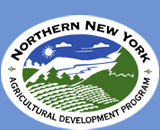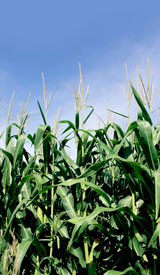


May 14, 2007
Contact: Everett Thomas, WH Miner Institute, 518-846-7121 x115
Cutting Height Impacts Alfalfa Harvest: New Resource Online for NNY
Farmers
The Northern New York Agricultural Development Program has posted a new
resource for alfalfa growers online at www.nnyagdev.org. Now available
via the Internet is a report, published by The William H. Miner
Agricultural Research Institute in Chazy, NY, on �The effect of cutting
height on the yield and quality of alfalfa in Northern New York.�
Alfalfa is a valuable feed crop for dairy production. Approximately
700,000 acres of alfalfa and alfalfa mixes are grown across New York
State.
The eight-page report provides details on the results of an evaluation
of an alfalfa crop and an alfalfa-grass mix cut at the currently
recommended height of two inches compared to a four-inch height that has
been commonly used on farms. The trial took place at The Miner
Institute.
Alfalfa cutting height project leader and Miner Institute Vice President
of Agricultural Programs Everett D. Thomas says, �Clearly, mowing closer
to the ground will yield more forage. Quality is the issue. Dairy cows
need high quality forage to produce milk.�
Thomas says the research team concludes �that despite the lack of
meaningful differences in forage quality between the cutting height
methods, there is a difference in the potential milk yield from the
forage. Overall, there is little difference in the quality of forage
harvested when an alfalfa/grass mix is cut at two or four inches. There
is an indication of a difference in the yield from the hand harvest
data, with the two-inch cutting height yielding more forage, as
expected.�
Results of the Milk2000 model used to evaluate the yield and quality of
the alfalfa/grass that was hand-harvested in the NNY research trial
showed the 2-inch cutting height resulted in more milk per acre at each
cutting. Thomas says while the forage harvested at the 4-inch height is
slightly higher in quality, the higher yield per acre for the 2-inch
cutting height will result in more milk per acre.
Thomas notes that research conducted in Wisconsin concluded that over a
3-cut season, milk yield increased by 900 lbs per acre with each
one-inch reduction in cutting height.
�The Wisconsin researchers, however, also concluded that for each
one-inch reduction in cutting height forage quality decreased an average
of four units of relative feed value (RFV) (Wiersma and Weiderholt,
2001),� Thomas says. �The Northern New York project did not measure RFV,
but found that alfalfa harvested at the four-inch cutting height had
only a four percent higher predicted milk production per ton. We do not
think this justifies losing half a ton of dry matter per acre, which is
what found when we harvested the crop three times.�
The milk per ton MILK2000 calculation for the mechanically-cut alfalfa
fields was 2,615 and 2,813 lbs of milk per ton for the average of the
two cuts. The differences in the actual cutting heights with the
conventional mower were 1.46 inches for the first cut (2.94 inches vs.
4.40 inches), 1.23 inches for the second cut (2.64 inches vs.
3.87inches), and 1 inch for the third cut (3.75 inches vs. 4.75 inches).
�It appears that the decision on alfalfa/grass cutting height should be
made based on field conditions, the needs for forage, and the grass
species planted,� Thomas concludes.
The research team for this project, funded by the grant from the
Northern New York Agricultural Development Program, included Catherine
S. Ballard (Director of Research), Kurt W. Cotanch (Director of Forage
Lab), Heather M. Wolford (Research Technician), and Sally A. Flis
(Research Graduate Student), all of The William H. Miner Agricultural
Research Institute.
The Northern New York Agricultural Development Program funds research
and education outreach for Essex, Clinton, Franklin, St. Lawrence, Lewis
and Jefferson counties. The Program is currently funding research on
breeding alfalfa snout beetle-resistant alfalfa varieties and on
developing biological controls to help farmers cope with the alfalfa
pest. The complete report for the alfalfa cutting height project is
online at www.nnyagdev.org in the Crops fact sheets section; it is also
posted in the Research Publications section at
www.whminer.com. # # #
